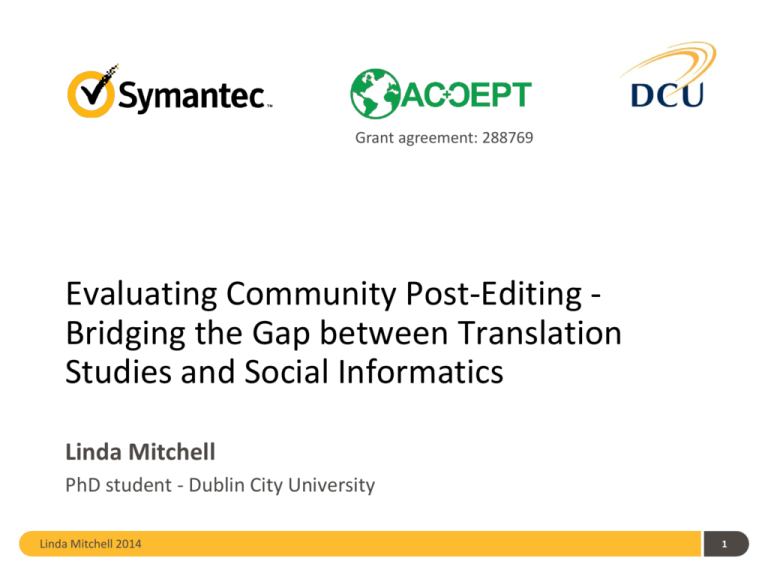
Grant agreement: 288769
Evaluating Community Post-Editing Bridging the Gap between Translation
Studies and Social Informatics
Linda Mitchell
PhD student - Dublin City University
Linda Mitchell 2014
1
Outline
• Research Topic
• Social Informatics
– The Norton Community
– Recruitment
• Overview: Evaluation Methods
– Developing the Evaluation Widget
Linda Mitchell 2014
2
Research Topic
Post-editing of user-generated machine translated content by
volunteer community members of the Norton support forum
• Norton Forum:
online platform to exchange knowledge on
Norton products
• User-generated:
The content are questions and answers
written by community members
• Machine translated: translated from English into German using
an SMT system
• Post-editing:
Correction of machine translated content
• Volunteers:
users of the Norton forums (not translators)
Linda Mitchell 2014
3
Research Topic
Linda Mitchell 2014
4
Main research question
• What kind of output do volunteer community post-editors
produce?
• Translation Studies: quantitative methods
– Categorise errors, rank post-editing solutions etc.
• Post-editing quality:
– “a good post-editor would meet the requirements of the
specific PE tasks at hand, making changes and corrections
only according to the guidelines provided, and delivering a
final text with the required level of quality in the time-frame
specified” (de Almeida 2013)
Requirements and level of quality depend on environment
Linda Mitchell 2014
5
The need for Social Informatics
• Post-editing environment is an existing online community
• …Body of research that examines the social aspects of
computerisation
• Design and configuration of information systems that work well
for people and help support their work (Kling 2000)
• Community needs to be studied to perform:
– Recruitment and support of participants
– Design of Evaluation Widget and tasks
• Qualitative Methods (observation, questionnaires,
communication)
Linda Mitchell 2014
6
Online Community – Analysis I
• They will be communities not of common location, but of
common interest (Rheingold 2000: 9)
• The Norton community:
– Main interest: receiving help and solving problems related to
Norton products
– Secondary interest: exchanging ideas about (new) Norton
products, how to improve Norton products
– Tertiary interest: forming bonds with other community
members
• Community PE <> Crowd PE
Linda Mitchell 2014
7
Online Community – Analysis II
• Self-sustained:
– Questions and answers are supplied by the community
• Self-governed:
– Moderators and administrators monitor
– Community reports/takes care of misconduct itself
Inception
Creation
Maturity
Growth
Online Communities
Life-Cycle
(Iriberri & Leroy 2009)
Death
Linda Mitchell 2014
8
Online Community – Analysis III
Guru
Onceoff user
Regular
user
Lurker
Linda Mitchell 2014
9
Recruitment
• User Study 1: (Mitchell, Roturier and O’Brien 2013)
– No natural interest for MT or PE
– Low cooperativeness from super users
• User Study 2:
– Public posts are seen but do not stir interest
– Personalised messages!
– Positive turnout:
•91 invitations 18 participants (20%)
Linda Mitchell 2014
10
My Evaluation Methods
• Linguistic Evaluation
– Error categorisation based on de Almeida 2013
• Professional Evaluation
– Domain experts
– Advanced language skills/ trained linguists
– Fluency and fidelity (LDC 2005)
• Community Evaluation
– Fluency
Linda Mitchell 2014
Quantitative
methods
(Translation
Studies)
Facilitated by qualitative
methods (Social Informatics)
11
Developing Evaluation Widget
Linda Mitchell 2014
(Mitchell and Roturier 2012)
12
Developing Evaluation Widget – Learning Points
• Simple Design
• Visibility
• Simple Task
• Provide Support/ Explanation
• (Fun / Rewarding Task)
Linda Mitchell 2014
13
Implementation
Linda Mitchell 2014
14
Grant agreement: 288769
Thank you!
Linda Mitchell
linda.mitchell7@mail.dcu.ie
Copyright © 2012 Symantec Corporation. All rights reserved. Symantec and the Symantec Logo are trademarks or registered trademarks of Symantec Corporation or its affiliates in
the U.S. and other countries. Other names may be trademarks of their respective owners.
This document is provided for informational purposes only and is not intended as advertising. All warranties relating to the information in this document, either express or implied,
are disclaimed to the maximum extent allowed by law. The information in this document is subject to change without notice.
Linda Mitchell 2014
15
References
• De Almeida, G. 2013. Translating the post-editor: an investigation of post-editing
changes and correlations with professional experience across two Romance
languages. PhD dissertation. Dublin City University.
• Iriberri, A. and Leroy, G. 2009. A life-cycle perspective on online community
success. ACM Computing Surveys, 41(2): 1-29.
• Kling, R. 2000. Learning About Information Technologies and Social Change: The
Contribution of Social Informatics. The Information Society, 16: 217-232.
• Linguistic Data Consortium. 2005 Linguistic data annotation specification:
assessment of fluency and adequacy in translations Revision 1.5,
http://projects.ldc.upenn.edu/TIDES.Translation/TransAssess04.pdf
• Mitchell, L and Roturier, J. 2012. Evaluation of Machine-Translated User
Generated Content: A pilot study based on User Ratings. Proceedings of the 16th
Annual Meeting of the European Association for Machine Translation, 61-64.
• Mitchell, L. Roturier, J. and O’Brien, S. 2013. Community-based post-editing of
machine-translated content: monolingual vs. bilingual. Proceedings of MT
Summit XIV Workshop on Post-editing Technology and Practice.
• Rheingold, H. 2000. The Virtual Community: Homesteading on the Electronic
Frontier. Cambridge: MIT Press.
Linda Mitchell 2014
16








